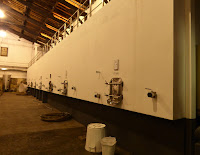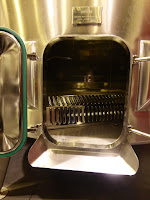Best 6 vineyards to visit in Bordeaux
Bordeaux Wine Experience – Medoc
& St-Emilion: Part 2
This
3-night tour included two full days touring vineyards and Grand Cru winemakers
in the Medoc and St-Emilion areas of Bordeaux. You would expect a visit to 6
vineyards to be boring by the end – after all, each vineyard looks pretty much
like another. Although the basic process of growing vines and making wine is
the same, we were fascinated by the touches that made each one unique.

A
few basic facts about making wine in this region:
- - Everything relies on the “terroir” – soil composition,
natural environment, drainage
- -The Medoc was swamp until 17th century when the
Dutch helped to drain it and plant vines. Bordeaux was the biggest port after
London during 17th and 18th centuries
-
It is flat, mainly gravel so ideal for cabernet sauvignon grapes
harvested around September. It takes two vines to produce one bottle of wine
-
With AOC appellation they are obliged to give % of production
to government, so give them the dregs basically! This is used to produce
commercial alcohol products.
-
St-Emilion region is hilly and dates back to Roman times as a
vine-growing area.
-
Young vines produce higher yield but less intense-flavored
grapes; mature vines produce fewer grapes, but their flavor is much more
concentrated. It is forbidden to irrigate vines over 3 years old - they are supposed to struggle to survive!
Chateau Lafon-Rochet, Tesseron
The
first we visited, this is a super-modern building with temperature of
individual vats and air-conditioning all controlled by computer. A brilliant
large-screen display monitors every element of the process for each tank. They
have reverted to concrete for their vats but still use French oak barrels.
A
large estate, they sell wine as ‘futures’ – merchants visit, taste the not-yet
bottled wine, order and pay up front for delivery around 18-24 months after
grapes are picked. Good cash-flow system. We tasted some direct from a barrel,
so not matured, then two more bottled but still young. Tannins stronger than
they will be after more years in the bottle, but you get a feel for how they
will taste in the future.
Chateau Maucaillou
Cecile
was very informative, explaining their choice of stainless steel vats and their
30% turnover of new oak barrels each year. All the winemakers we visited use
barrels for around 3 years then replace them with new, selling on the older
ones to whisky or brandy distillers.
They
have an excellent museum on site, very smooth samples of their rich, red Grand
Cru wines to try, and a stunning Chateau that also provides accommodation and
tuition as an Ecole du Vin. An attractive option for the future, I think.
Chateau Giscours
A
stunning chateau, this is a film-maker’s dream location. It has a more
traditional approach with original large concrete vats, each section related to
a specific plot and grape variety on the estate, limited to just one tank this
year given the exceptionally poor start to 2017. It was interesting to hear how
sulphites are used – the cause of the dreaded hangover apparently.

Three
different wines to sample, and everyone getting braver with comments about the
smells and flavors they could recognize, though not necessarily correctly. However,
you can tell the difference between younger and more mature, mellower wines. We
invested in one of their beautiful glass decanters though no wine this trip.
Chateau du Tailhas, Pomerol
Day
2 starts with our trip to the St-Emilion region and Chateau du Tailhas – Pomerol, unique in this area as it is very flat with a light, sandy soil. They grow
mainly cabernet sauvignon grape variety, the vines always grafted onto American
root stock as this is resistant to disease in the soil.
Mr Nebout explained how the barrel makers flavor the barrels by burning the inside surface, intensifying the oaky aromas.
Mr Nebout explained how the barrel makers flavor the barrels by burning the inside surface, intensifying the oaky aromas.
Very
impressive cellars and steel tanks, with wonderful smooth reds for us to
sample. This is an internationally renowned producer with some very prestigious
(and expensive!) wines available.
Chateau Guadet
Right
in the centre of St-Emilion village, this was the most unusual winemaker we
visited. The owner had sold the Spar shops chain and bought this business, now
experimenting with different methods of fermenting including terracotta storage
jars like those used in ancient Greece. The vineyards are in the surrounding countryside,
of course, but the grapes are brought directly to the chateau for processing.
A
visit to the cellar is an adventure! We are talking old, low-ceiling tunnels
winding under the house for 3 Km, the final section for the private collection
of wines from every vintage, some more than 100 years old. It felt very odd to
emerge inside the kitchen of the main house at the end of the tunnel.
Tasting
this time involved a walk through the old town, very steep narrow paths, to one
of the largest wine shops. Three more reds to try then on to our delicious
lunch at L’Envers du Décor.
Chateau Champion
Our
final visit was to a small family-run estate owned by the family since 18th
century. They have now added two further small estates nearby, Chateau Vieux
Grand Faurie and Chateau Haute Terrasse. With such poor weather this year,
these chateaux have lost between 60%-100% of their crop – not an immediate
effect as it is around 18 months before it would be sold, but 2019 will be very
difficult for them. Unlike some of the other vineyards, they sell bottled wine
to individual customers rather than as futures to larger wine merchants. We
were very fortunate to see a traditional small-scale producer and taste wine
from all three chateaux.

We gained some valuable insights into the basic wine-making techniques, how each Chateau differentiated their wines, and the critical importance of the terroir. Even after a short visit like this, we can see how important the vintage is and the negative impact on smaller vineyards when nature destroys their harvest. 2017 will be a poor vintage, but then so was 1948 apparently!















Comments
Post a Comment